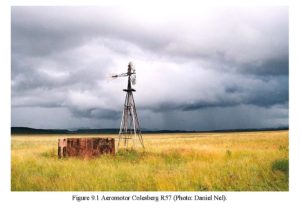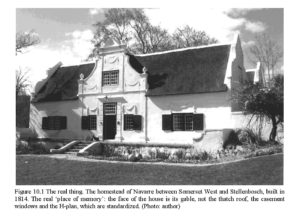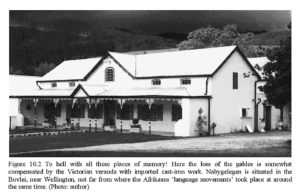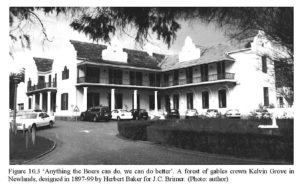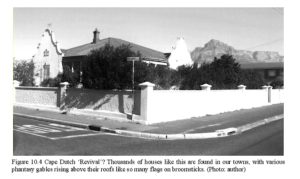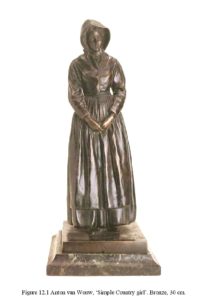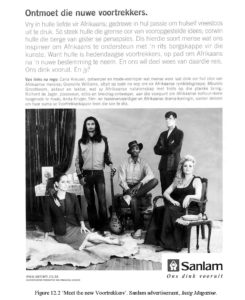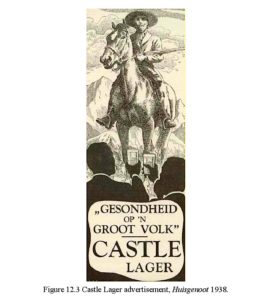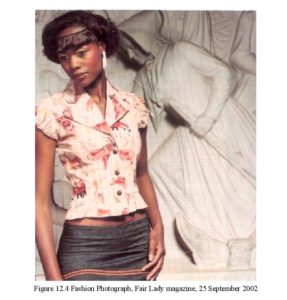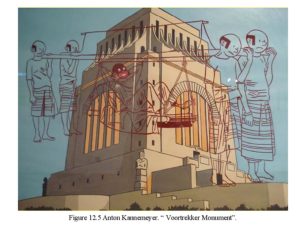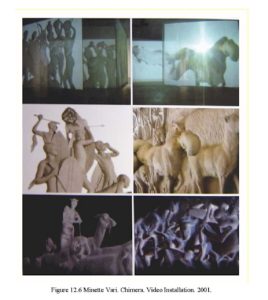Reshaping Remembrance ~ The Eating Afrikaner: Notes For A Concise Typology
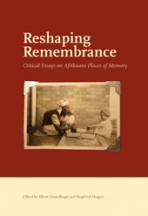 … eating is one of the principal forms of commerce between ourselves and the world, and one of the principal factors in constituting our relations with other people.[i]
… eating is one of the principal forms of commerce between ourselves and the world, and one of the principal factors in constituting our relations with other people.[i]
On the glamorous and the mundane
Of course the mouth is the entrance to an exit, about which, as Dean Swift would tell you, one might also be concerned; but for the moment we can sit on that subject, leaving the phenomenology of its outbreathings to make the reputation of some Sehr Gelehrter Prof. Dr. Krapphauser, or Swami Poepananda. Om![ii]
Versfeld’s joke resonates with Wilma Stockenström’s somewhat grim image of a human being: ‘behaarde buis van glorie en smet’ [hairy tube of glory and smut].[iii] At one end of the tube, one could say, a human being ingests less or more elaborately prepared earthly sustenance, as the everyday patty or as paté de foie gras, in a ritualised or ceremonial manner, only to return it to the earth at the other end in a humbler form and mostly in an unceremonious fashion. Indeed, it is a trajectory ‘van glans én van vergetelheid’ [of the glamorous and the mundane].[iv]
This thought alone should be sufficient to put into perspective the quest for an original and essential Afrikaner kitchen. Curiously enough, this line of thinking is pursued to absurd lengths in current fascistoid confabulations about Afrikaner ethnic identity: the ‘smut’ and the ‘glory’, the abject and the heroic, are regarded as elements comprising a self-sustaining feedback loop of ethnic preparedness. The violence of colonialism, the road-kill of history, so to speak, should not be rejected or forgotten by the Afrikaner volk, but ritualistically embraced and imbibed in order to build up strength for what is envisaged as a renewed struggle for self-preservation, under a perceived threat of future ethnic violence.
Inasmuch as these bizarre fantasies are motivated by self-preservation, they constitute, paradoxically, an example of a general weakness in the Afrikaner culture, including the food culture. This debilitating weakness is the result of a misconception of what might command attention and respect: only the glorious struggle and shining surface of nationalist preparedness. In perceptions of this nature the ‘smut’ aspect is fully subsumed under the ‘glory’ aspect. The humble, the abject is not valued in its own right, but only embraced if it can serve a higher, more heroic purpose.
The gist of my speculations in this essay is that it is precisely the inflated attention and respect for the ‘glamour’ and for the moment of permanence, a narcissistic moment, which undermines the Afrikaner culinary tradition from the inside. To illustrate this, I wish to present for consideration a number of notions and practices within specific sections of the Afrikaner community; consideration not by just anyone, but particularly by the purgative and imaginative spirit of the late Martin Versfeld. It was he, who, in his wise, humorous and mischievious essays, presented his calvinistic fellow-Afrikaners with a sensual ethic of eating and cooking, an ethic where the splendour and the simplicity, the glamorous and the mundane of eating and cooking are poetically intertwined. Moreover, it is an ethic which contains both the permanence and the transcendence, of the kitchen and of the table, within a horizon of attention and respect. One could object that Versfeld lights up this whole horizon with the glory of god. Nonetheless, my answer would be that the glory of the kind of god Versfeld believes in seems to me a far more appealing option than the glory of an ethnically exclusive tribe. One reason for this appeal, is that he can easily recognize his god in the gods of other cultures and enrich and modulate his faith with wisdom from a variety of sources.[v]
The big eat
We can never be festive if we wish each day to be a feast. Where everything is festive nothing is festive. … It is gluttonous, perhaps deadly to want that every day.[vi]
In the daily round of contemporary consumer madness it is precisely the rhythm of festivity and everyday domesticity, of indulgence and staple that is corrupted. This corruption is fostered by the images of bedecked tables and plated food presented in popular lifestyle magazines. The culinary festive and glamorous occasion is celebrated ad nauseum. Should one contend that the contemporary Afrikaner’s way with food has to a great extent become absorbed by the extravagant consumer culture, then one could claim that this could only have happened because, apart from a tradition of domestic simplicity, modesty, even frugality, another tradition, one of over-indulgence and lavish ostentation, is also associated with the Afrikaner culinary tradition. Moreover, this tradition has been an important instrument of social ranking ever since the early days of the Cape Colony.
Memories of the simplicity and frugality at the one end of the traditional Afrikaner table are preserved in the whimsical names of simple dishes. In the mealie-growing region of the Free State, ‘pap-en-tik’ [porridge-and-tap] is the common name of the dish consisting of a piece of sausage in the middle of the table against which everyone taps their lump of dry porridge before putting it in their mouth. ‘Stadige intrap’ [treading slowly] is a Strandveld name for thick bean soup. To the same category belongs the idea of a ‘lang sous’ [long gravy], made by adding liquid to a dish and thickening it with flour to ‘stretch’ the meat and give everyone a taste. Another name that originated in the frugal kitchen is ‘wurgpatat’ [choke-down sweet potato], which obviously refers to the lack of lubricating accompaniment. ‘Slinger-om-die-smoel’ [sling-around-the-trap] is an old folk name for ‘melksnysels’ [home-made noodles cooked in milk, served with cinnamon and sugar]. ‘Skop’ is ‘skaap se kop’ [sheep’s head]. ‘Konsentrasiekamppoeding’ [concentration camp pudding] is the name of the brown pudding my godmother in the Karoo used to bake. A ‘poek vet en ‘n homp brood’ [a lump of fat and a chunk of bread] was staple food for people in the Swartland wheatlands in the 1930’s.
The ‘poek’ and the ‘homp was enjoyed with a dried ‘bokkom’, which was selected from the bunch of ‘omkykers’ [backward lookers] in the small, dark, corrugated iron garage under the bluegum trees at Koperfontein; ‘omkykers’ because once they have been strung together through the gills, the springers [a type of mullet] all seem to look backwards in the same direction – improbable, faintly shimmering cherubs from a forgotten ocean.
It is precisely this simplicity, the meagre table, and even the bare cupboard, which seems to give rise to humorous names. This type of humour is also found in institutions with a tradition of questionable fare, such as hostels and the defence force. Apparently, in these circumstances a certain kind of mutually sympathetic and intimate relationship thrives among people; the shared memories of questionable culinary offerings seem to bind them together in a community, the members of which can still laugh together knowingly, long after the ‘varkslaai’ [pig salad, a green pineapple jam] and ‘Loch Nessbredie’ [Loch Ness stew, a runny stew in which lumps of meat would ominously raise their heads] have disappeared from their diet.
Besides the mundane aspect of the Afrikaner table – the ‘stretched’ stew, the ‘choked-down’ sweet potato and the ‘tapped’ sausage – there is the other end of the table, the glory aspect. ‘Man, dit was vir jou ‘n grooteet’ [Now, that was a big eat for you] you still hear older people say, after attending a wedding or a funeral. The eyes grow a bit rounder when they say that, and the smile is somewhat abashed, the local equivalent of ‘the embarrassment of riches’ referred to by Simon Schama in his book of the same title about the prosperity of the Netherlands in the seventeenth century.[vii] Indeed, ‘the big eat’ may be the primary rubric for discussing the food tradition of the Afrikaners, a people characterised in its rural origins by stout ‘tantes’ [aunties] and portly ‘ooms’ [uncles]. The anorexic ‘Boerenooi’ [Boer girl] is a product of the second half of the twentieth century. In Jan F.E. Cilliers’s rural idyll of 1911, Martje (later Martjie), Roelof, the suitor, comes calling on a Sunday afternoon, not wishing to disturb oom Koot and tant Mieta, who, after the heavy Sunday lunch, are probably dozing side by side in the half-light of their bedroom, just like the pig Adam, ‘stilbrommend van innig genot’ [softly grunting with profound satisfaction]. Then Martjie appears around the corner, ‘’n mooi slanke meisiesgestalte/in haelwit Sondagse klere’ [the pretty, slender figure of a girl/in a snow-white Sunday dress].[viii] In keeping with my image of the period, she would rather have been what the Dutch call ‘volslank’ [well-rounded] and Roelof would appropriately have been ‘’n fris Boerseun’ [a strapping farm boy]. Being slim was not in fashion in those days, as is clearly illustrated by the old patriarchal Afrikaans expressions referring to the female behind, such as ‘boude soos mosbolle’ [buttocks round as buns] or ‘sy stap een-vir-jou-een-vir-my’ [she walks onefor-you-one-for-me].
‘The big eat’ on the farm has an equivalent in town and city life, in the elevated anglicised expression ‘om ’n goeie tafel te hou’ [keeping a good table]. Of course, the raison d’être of such a table is to be regularly inspected by peers with equally endowed tables. After all, what is a good table without equally admired admirers? The big eat and showing off the big eat are inseperable. This thought is expressed in the work of Karel Schoeman. I am reminded of passages in Verkenning [Reconnaissance] where he describes the phenomenon of ‘the big eat’ in great detail. In the chapter on Stellenbosch he writes about the lifestyle of the townspeople from the perspective of the Dutch traveller. ‘(D)ie groot huise in hul tuine, verskole agter bome, waar die vertrekke altyd koel en skaduagtig is, die voetval van die slawe, die kwistige vertoon. Die protserigheid en opsigtigheid, die oordadige maaltye …’ [the big houses in their gardens, hidden behind trees, where the rooms are always cool and shaded, the tread of the slaves’ feet, the ostentation. The affectation and showiness, the excessive meals …].[ix] During the wedding feast the young man is astounded by the dishes of food brought out by the slaves and the way people ‘(uit)reik om te sny en te skep en hulle borde vol te laai: kerries en pasteie en gebraaide vleis en hoenders, en ‘n hele gebraaide vark wat onder algemene toejuiging opgedis en van tafel na tafel rondgedra word’ [stretch across the table to cut and dish up food and heap it onto their plates: curries and pies and roasted meat and chicken, and a whole roasted pig which is served amid general cheering and carried from table to table].[x]
It would seem that this depiction by Schoeman is no mere authorial fantasy about the early life in the Cape Colony. In her book Die geskiedenis van Boerekos 1652-1806 [The history of Boerekos 1652-1806], Hettie Claassens provides ample support for Schoeman’s portrayal. In the chapter about the Cape community between 1707 and 1806, Claassens quotes from a letter written in 1710 by the husband of Jan van Riebeeck’s granddaughter, where he writes: ‘‘t is of de Caab van vretten en suypen aan malkander hangt’ [the people at the Cape seem to do nothing else but guzzle and gorge themselves].[xi] Similarly, Cornelis de Jongh writes about the Cape colonists in his travel journal of 1791-1797: ‘Over het geheel ken ik geen menschen, die sterker eten, sterker drinken en meer slapen’ [In general, I know no other people who can eat more, drink more or sleep more].[xii] Lady Anne Barnard gives an account of the meal she enjoyed in 1797 in Wellington, at the house of one Benjamin Weigt, which included rice, a Cape ham, a well-larded leg of venison, two ducks, chicken curry, beans, cabbage, a salad garnished with two dozen hard-boiled eggs, as well as a baked custard, various pastries and strawberries for dessert.[xiii]
According to Claassens the ostentation and class consciousness at the Cape can to some degree be attributed to the example set by the hierarchical structure of the VOC [Vereenigde Oost-Indische Compagnie, the Dutch East India Company]. The table was regarded as the place where the host could demonstrate his position and wealth as an independent and authoritative person in his own right. As was typical of seventeenth century Europeans, the excessive use of spices would initially have served as a status symbol. On the other hand, the culture of culinary display at the Cape can be seen as a reaction to the privation suffered by the early settlers during the first decade of the supply station. It could also have been an imitation of the opulent tables in eighteenth century Europe, where the number of dishes allowed to be served during a meal had to be restricted by law.[xiv]
Sweet, sour and savory: The old-Dutch palate at the Cape
I am unable to be too ethnic about [a pukka South indian curry]. My French forebears prod me. I remember Moitjie’s insistence on tamarind, and our Cape custom of putting fruit into things. Most curry recipes I know make little use of fruit, whereas I prefer fruity curries. A handful of dates is good, and so is apple, quince, banana or pawpaw.[xv]
Apart from the habitual excess and great variety of dishes on the wealthy tables of the Cape Colony, there are, according to Claassens, further historical signs of a European food culture that migrated to the Cape with the Dutch settlers and could already be discerned by 1725. She concludes that the typical ‘boerekos’ dishes developed from this culinary culture. The Dutch, according to her, already had a fully developed spice cuisine. Boerekos dishes such as smoorsmoek [braised snoek, a firm, fatty sea fish which is abundant during the winter months], fish soup, bokkoms, stews, sosaties [cubed lamb, onions and apricots threaded on a skewer and marinated in a curry sauce], curries, yellow rice with raisins, atjar, sambal and blatjang [various spicy condiments] are, as the result of a widely accepted historical misunderstanding, erroneously attributed to the influence of slaves from the East.[xvi] Leipoldt, the Afrikaans poet, writer and gourmet, whose work is referred to by most contemporary experts on boerekos, describes the use of certain combinations of Eastern spices in curries and stews, and the combination of sweet-sour and sweet-savoury in the cookery of the Cape Moslem community.[xvii] According to Claassens it would have been unthinkable for people from a higher social class to copy the food culture of the lower classes. She maintains that it would have been those on the lowest rung of the social ladder, the slaves, who would have adopted the dominant culinary style of the Dutch and, through the ages, would have conserved it even better than the original rulers. Furthermore, according to Claassens, there were before 1725 too few slaves at the Cape, who were too widely distributed and ethnically heterogeneous to have had an influence on the cuisine.[xviii] This argument proposed by Claassens, which can be contested at every turn, already betrays an ideological agenda to ascribe an authentic European-rooted kitchen to the Afrikaner, a matter I will return to later in this essay.
The present-day custom of rural Afrikaners to serve stewed peaches, quinces, sweet potatoes stewed in sugar or pumpkin fritters with lamb, or grape jam with snoek, and to prepare mild curries, stews and pickles with a fruity sweet-sour base can be traced back to this early Dutch cookery. According to Claassens these sweet-sour and sweet-savoury combinations reached the Dutch food culture via Italy and later France. The French and Italians originally acquired these combinations from the Persian and Arabic cookery traditions. The Chinese and Indonesian food cultures can also trace their cookery traditions back to the influential Persian culinary style. Furthermore, she avers that the sophistication of the Dutch culinary customs disappeared during the British occupation, when the culinary tradition of the ruling culture was adopted by the locals. Herbs and spices completely disappeared from the Afrikaner food culture. The privations of the Great Trek and the Anglo-Boer War further impoverished the Afrikaner food culture.
The continuation of this impoverishment into the twentieth century can easily be detected in the difference between Leipoldt’s tamatiebredie [tomato stew] and the version in S.J.A. de Villiers’s standard handbook for Afrikaans kitchens, Kook en Geniet [Cook and enjoy it]. Leipoldt includes ginger, cardamom, coriander, peppercorns, fennel seeds, thyme, chilli, marjoram, garlic leaves, chutney, sugar and a glass of wine,[xix] while De Villiers suggests only salt, peppercorns and sugar as flavouring.[xx] It was only in the last quarter of the twentieth century, Claassens states, that Afrikaners started rediscovering their old Dutch traditions, influenced by leading chefs such as Peter Veldsman.[xxi].
Although one may disagree with Claassens about the assumption that the lower classes imitate the cookery of the rich and mighty (where would they obtain the means?), her book however reminds one of the historical origins of everyday
phenomena. Nowadays, in the upmarket supermarkets like Spar, in a town like Stellenbosch, a wide assortiment of labelled, prepacked, precooked meals, including ‘Traditional bobotie’, ‘Karoo lamb pie’ and ‘Cape tomato bredie’, is available for Afrikaners who do not have time to cook. These dishes are mostly pale imitations, not only of the tradition, but also with regard to the care and attention, the time and talent that went into these dishes. For someone from a traditional Afrikaner food background, what is missing here is precisely the desired intense balance and combination of sweet, sour and savoury. The panacea for this problem is, of course, Mrs Ball’s Chutney, the bottled commercial version of the old Cape sweet-sour tradition.
For the outsider, this tradition is inconceivable. At the buffet counter of the supermarket, tourists from the Low Countries will be found staring incredulously when local clients dish up sweet pumpkin mash with slices of roasted lamb in squeaky Styrofoam containers. They linger before the dish of syrupy sweet potato: ‘Wat raar,’ they say to each other, ‘het schijnt erg zoet te zijn, mischien is het een toetje.’ [How strange, it looks quite sweet, perhaps it’s a dessert.] And yet, the Dutch today still enjoy sweet applesauce with their pork, and the Flemish gourmands cook their rabbit with prunes.
The rondebord, the braai and the potjie: Three eating habits of the Afrikaner of the ‘old sort’
Eating is not only a physical process; it is also a spiritual process. Your food could not enter your mouth if it did not first enter your mind. You are what you eat, but you also eat what you are.[xxii]
This could be the appropriate moment to present the first type in the classification of The Eating Afrikaner: The Old Sort (I mostly limit my observations to the Afrikaner man, who is generally at the receiving end of the culinary efforts of the Afrikaner woman). The Old Sort is the counterpart of his ideal black employee, whom he would refer to as ‘one of the old sort’. For this type of Afrikaner, and probably for his employee as well, the index of a satisfying meal would be the ‘Rondebordkos’ [the round plate of food].
The round plate of food should essentially include the following: a variety of meats and vegetables, one or more kinds of starch, plus something sweet, such as pumpkin or sweet potato, and something sour, such as tomato salad or beet salad with raw onions and vinegar. Without meat, the plate is definitely not round enough. Meat is absolutely essential. On Sundays the plate must be especially round. That is the splendour and glory day of round plates.
For the Old Sort of Afrikaner (the Consumer of the Round Plate who would be quite at a loss if he had to prepare any of the round plate dishes) the food on the round plate should be prepared and served by his own wife. Fragrantly steaming in porcelain serving dishes, the food is commended to the Heavenly Father (‘For what we are about to receive …’) by the Patriarch of the Round Plate, flanked by reverent offspring and their spouses, whose children – these days probably preferring Steers burgers as their favourite fare – may be seen at the table but not heard.
For the Patriarch of the Round Plate (but no longer for his children) pasta, quiche and green salad is food for gays. Vegetarians are even more alternative than gays, they must be lesbian. Sushi is quite beyond the pale. The Afrikaner of the Round Plate believes in the scrum. He believes in the one-and-only back line movement culminating when the fly-half dives across the try line and plants the ball under the corner flag. He abhors professional rugby. He curses the quota system. He misses Frik du Preez, the legendary Springbok lock, sometimes flank, mostly dashing all-rounder from the glory days of rugby heroics.
After the rugby he does not necessarily expect the Round Plate. Then it is time for the Braai, time to bond with the men and with Castle Lager. The fire and the good cheer provide the splendour, supplemented by generous quantities of lamb chops, marinated pork sosaties and spiced boerewors. In the kitchen, the women make banana salad with a dressing of condensed milk and mayonnaise, if it is in the Boland [winter rainfall area of the Western Cape], or ‘stywepap’ [firm maize-meal porridge] with a spicy tomato sauce, if it is up North. The Braai, please note, also requires a sweet-sour accompaniment.
The third best meal for the Afrikaner of the Old Sort is something between the Braai and the Round Plate, called the Potjie [a small pot]. The Potjie is usually prepared according to a recipe attributed to some retired politician or pop singer or long-distancerunner who did not become a pastor after the demise of apartheid. Apart from a potpourri of ingredients, ample quantities of good red wine is traditionally required for the glory of the Potjie. The wine is mostly poured into the Preparers of the Potjie, rather than into the Potjie. By the time the Potjie is ready, no-one is sober enough to realise that the contents is partly tough, partly cooked to a mush and mostly burnt. Add salt and a dash of Mrs Ball’s and all is well. As Versfeld says: ‘Cooking and (the burnt) offering have always gone together’.[xxiii]
The culinary guild
The conditions for good cooking are something like the conditions for good writing. You must know, in some fecund and global manner, what you want to say, but the result should have some surprises for you. You must love what you are doing, but you cannot love what holds no surprises for you …
Hence a good dish is like a good moral action – something has popped up into it from that mysterious being, the person. One must avoid cooking by canon law. You should be able to recognise a good cook by his dish, as you can recognise a great writer by any of his paragraphs. They express his essential liberty … One must be careful about copying even oneself, since the self one is copying is dead, and repetition would be spiritual suicide.[xxiv]
An interesting phase in the metamorphosis of the Afrikaner of the Old Sort, is that of the suburban connoisseur, flourishing in select residential areas such as Waterkloof and Oranjezicht. Their emergence is associated with the Afrikaner’s establishment as a member of the upper middle class and with the political power of his Party. The connoisseur is a glamorous persona of the volk and their food is a glorious manifestation of their identity. In the example I would like to present, they are further endowed with a glistening layer of belles-lettres fat, the product of the abundant inspiration to be found in the wine-producing university town of Stellenbosch. They belong to a self-conscious group of cooks and tasters harbouring a formal mutual respect. The group calls itself a guild, and the guild represents the will to preserve that which is authentic and unique. In all probability not many of the members of this congregation would agree with Versfeld that tradition is nothing more than a constant capacity for change.
The book with the significant title So eet ons in Stellenbosch (SEO), also translated into English as The way we eat in Stellenbosch (WWE),[xxv] was published in 1979 by the Stellenbosch Fynproewersgilde (Culinary Guild) to commemorate the founding of their town three hundred years before. It serves as an example of the culinary suicide Versfeld refers to, not only because of the unimaginative recipes and the prosaic style in which it is written, but also because of the idea that tradition is eternally worthy of repetition. Apart from ‘eternalising’ an essential Stellenbosch food tradition, the book fulfils all the functions of ideology: concealment, distortion and reification.
To start with, the recipes are classified according to the seasons. The food tradition of Stellenbosch is thus presented as being deeply attuned to the rhythms of nature. Nature’s blessing is poetically bestowed by local Poet Laureate D.J. Opperman, the ‘scriba van die carbonari’ [scribe of the carbonari][xxvi] and appropriately translated for the English edition by C.J.D. Harvey. The poetry of canonised poets, as we know, is only a hair’s breadth removed from Holy Scripture. If, indeed, you are also a canonising poet (one who collects and selects Afrikaans poetry for the prescribing market) then your figurative pronouncements on the topic of quinces and snoek are nothing less than Blooms of the Stewing Pot that impart a rich, domestic lustre to your Blooms of Chaos and Blooms of Evil.
Subsequent to N.P. Van Wyk Louw’s ‘Vier Gebede by Jaargetye in die Boland’ [Four Prayers for Seasons in the Boland],[xxvii] the ‘naturalising’ of spiritual growth in terms of the seasons was nothing new in Afrikaans poetry. Although one would not compare the ‘witty’ occasional poems by Opperman with the lilting, pathos-steeped sonnets by Louw, both series of poems have something in common, even if the one depicts the supplications of the wanderer through the Boland and the other reflects the glow of the ample Boland hearth. Louw and Opperman both respectively imply that our well-being is maintained, not by our politically guaranteed class position, but by the irrefutable example, measure and mood of the seasons.
According to Opperman, during autumn you are inevitably ‘ontspanne’ [‘at your ease’] and you feel ‘ie eerste snoek (wat) in jou loop’ [‘dream of snoek’];[xxviii] during winter you speak ‘met intiemer tongval’ [‘in tones more intimate’] while within you the stones of the Eerste River are ‘ronder omgerol’ [‘rolled (…) smooth and round’].[xxix] Then in summer, ‘gloei jy van welbehae teenoor bure en besoekers’ [‘One feels for friends and neighbours new good will’].[xxx] For spring, the poet fashions something suggestive to titillate the pious Calvinists: a bit of springtime frivolity with sexual overtones and medieval troubadour nuances – so delightful that even the reverend can appreciate it [paraphrased below]:[xxxi]
Spring
The Peaks leaf through different moods, blue or green
but you are at peace with all around you:
the budding oak and plane, the marshes
pricked with pondweed, beds of leeks,
young carrots and asparagus – sticky gum
on early peaches, the sickle cut in wet barley,
and fragrant ploughed furrows. The monotonous call,
among the pines, of the red-chested cuckoo.
You carve [roasted] goose, guinea fowl and rabbit;
sing along to old refrains, drink young wines,
pick babiana and sparaxis … the modest
first peck at the red tips of strawberries.
The elevated nature-inspired rhetoric that Louw uses to express self-realisation is modulated by Opperman to a more earthy tone. The gracious living of the well-to-do, white Boland townsfolk is generalised to represent an indisputable natural standard of humanity. In keeping with this sentiment, the Fynproewers of Stellenbosch dedicate their book to ‘everyone who is interested in good food, which has always been closely associated with our traditional hospitality.’[xxxii]
The misconception underlying this ‘royal plural’ can be established quite easily by considering the book Vir ‘n stukkie brood [For a piece of bread], published six years later by the alternative Afrikaans publishing house Taurus. Here Sandra Kriel investigates the living conditions of coloured farmworkers in the Stellenbosch area. During her interviews with women, their cooking and eating habits are discussed. This book was one of the first documentations of this nature ever carried out in this area. It is an enduring reminder for everyone caught up in a middle class comfort zone that there is a moat of dirt poor coloured households, of alcohol abuse and suffering, surrounding the whitewashed fine dining culture. One could with a keen eye discern a historical continuity, leading from the strict social hierarchy of the early Cape colonial society under the V.O.C. to the Stellenbosch community of white gentleman farmers and later gentleman professors and even later gentleman directors and senators.
The following extract from Kriel’s interview with Rousie September [translated] not only illustrates something of the poor coloured family kitchen, but also of a language usage that is far removed from the poetic musings of the Poets Laureate of Stellenbosch.
I also scrape my own offal. Cook the offal. In water, strong hot water. Cowsheel, scrape it. Spotless clean. And when I scrape it in hot water … some people scald it in the fire, but not me, it turns pitch black, then it’s bitter, you see, but I scrape it clean in strong hot water … Water has to cook under the hoof to loosen it. Not too much. About ten minutes you should cook it. Then you should remove the hoof. If you cook it too much, then the hoof sticks. The hoof, I remove it and then I rinse the cowsheel. Wash it until it is clean and white. When it’s washed, then I cook that one cowsheel of mine. I make brawn. If I have offal, then I clean my offal. The head and trotters. I make curry offal.
Scald it clean the head. The tripe, I cook the same day. I scrape it in strong hot water. It’s … how do they say? membranes inside. Pull out the membrane, while it is still in the hot water, still strong hot. Inside membrane, the yellow membrane that’s inside. Pull off the outside membrane. Wash it and cut it into pieces. And then I cook it. With beans, or plain, the way I want it. Curry plain, the way I want it, and potatoes in small cubes. Rice on the side.[xxxiii]
Having read this account, one feels that the culinary connoisseurs could have chosen a somewhat more modest title for their book, for example: The way some of us eat in Stellenbosch.
Although an outspoken or thematic awareness of discontinuities, alterity and contradictions is not generally found in cookbooks, the absentees and outsiders in this gourmet book are made all the more conspicuous by the illustrations. On the cover we find, in keeping with the graciously civilised festive atmosphere of Opperman’s poems, drawings of the family crystal, dishes and candelabra against the background of the Peaks [mountain peaks in the Jonkershoek valley]. On the title page is a drawing of fruit and vegetables arranged on a wooden board in the classic style of the informally arranged cornucopia. But then follows a series of drawings that do not, as one would expect, depict professors in suit and tie and farmers in sports jackets and hostesses bedecked with fresh water pearls in chintzy dining rooms. The drawings are sentimental pastoral representations of a generalised yesteryear, where against the cliché of a Cape Dutch architectural background, coloured people, recognisable thanks to clear ethnical physiognomic markers, are represented as a securely nurtured and fully reconciled lower class. Quaintly they sell their fish from a cart,[xxxiv] contentedly they bend down in the vineyards to harvest the grapes.[xxxv] Apart from the reification of the food culture as a natural phenomenon, we are here confronted with the two other functions of ideology: distortion and concealment of the preconditions for the material possibilities of the lifeof the Stellenbosch connoisseur and the political and class formations of the period.
Taking into account these signs of the ‘misunderstanding’ under which the Culinary Guild laboured in the kitchen, one wonders how well developed their culinary taste buds really were. Aromat,[xxxvi] (commercial) curry powder,[xxxvii] margarine,[xxxviii] stock cubes,[xxxix] food colouring,[xl] custard powder,[xli] not to mention a packet of oxtail soup,[xlii] in the bobotie, surprisingly – these ingredients are all an indication of the lack of sophistication of these connoisseurs’ palates. One is compelled to take this book with a pinch of Aromat. It is an example of culinary amateurism, which in itself is not shameful – the kitchen is the playground of the amateur – but if amateurism is coupled with so much selfcongratulation and self-regard, something more than empathy with human nature is evoked. As counterfoil for the complacency in Opperman’s locally inspired decorative art in The way we eat in Stellenbosch, one is inadvertently reminded of Peter Blum’s criticism of the ‘unreality’ of the sentiment prevalent in the typical Boland town [paraphrased below]:
Sometimes in winter – when the rain sifts softly on lawns, thick and deep as carpet pile – when it conceals the rocky mountain range behind a curtain of mist – when at the window pane poplars, oaks and chestnut trees melt into each other, and we sink into leaf green dreams while we read about ancient civilisations – then the unreality transports us with the flow of calming waters, and in our mind’s eye the county of Surrey appears, grey and spent.[xliii]
The haute cuisine of the new Afrikaners
In the search for security, in the preservation of the ego, whether individual or collective, there is no peace.[xliv].
From the rural Round Plate eater it is but a small step across the railway line (with a hand-up from Sanlam, our corporate back-up) to the oak-lined uptown avenues, but from the Culinary Guild it is a giant leap to the coterie of the New Afrikaner and the international gourmet scene. The table is decorated in red and black, the big, round plate has made way for the big square plate, but that which is on the plate is small and is presented with artistic garnishing with Miro-esque precision and in Kokoschka-esque tones. The sweet-savoury and sweet-sour is still recognisable, but the quince is now whisked into a champagne mousse and served with the blue springbok filet, and the fig is reduced to a chestnut brown syrup in a pretty puddle under the pink kingklip. Welldone meat is the ultimate sin. The glamour and glory is complete, the purse of the Afrikaner Big Man and the Glam Femme by his side is bulging, well-connected to the international stock market.
This tendency seems to create some discomfort for the philosophers among the New Afrikaners. These philosophers, I gather, call themselves Die Vrye Afrikane [The Free ‘Afrikane’ as opposed to ‘Afrikaners’]. They cannot quite reconcile this extravagance and ostentation with their ‘re-imagination’ of the Afrikaner. As of late they have been particularly inclined to making pronouncements about the kind of novel they deem to be conducive to the development of a self-image for the newer, freer Afrikaner, the one who has cast aside the burden of guilt from the past. These novels include Oemkontoe vir die nasie [Umkontu for the nation] by Piet Haasbroek, Die Buiteveld [The Outfield] by John Miles[xlv] and Moltrein [Underground Train] by Dan Roodt.[xlvi] The philosophers mainly consider the content of the novels on the basis of their exemplariness, because, as all propagandists, these assorted Brüderlein have a very slight regard for the value and significance of literary form. Any form is acceptable as long as the message is pro-Afrikaner.
Where, one wonders, do these custodians of culture stand with regard to traditional boerekos? Die geskiedenis van Boerekos with its compelling argument supported by extensive historical research, could be appropriated by these circles as a call to return to the Source. In the introduction and concluding chapters, in particular, it would seem that Claassens attempts to attribute a unique and inalienable authentic food tradition to the Afrikaner volk. At the same time she wants to ascribe a rich and deep integrity to this food tradition, as well as an ancient, identifiable ‘Eurasian’ source. In this regard, it might be of significance to quote the concluding cadence of Die geskiedenis van Boerekos [translated below]:
The erroneous assumption about the origin of Boerekos which, for more than a century, has been regarded as valid, also by Afrikaners, shows how essential it is to take care when recording history. The culinary culture of a nation cannot be chopped into pieces and served out of context, but should be approached holistically. To fully understand the food culture of a people, it is necessary to throw its total human existence, its faith, political history, habitat, language and language evolution into one pot.[xlvii]
This drumbeat is waiting to be discovered by the cultural gatekeepers of the new generation. They could use it well to redeploy the tried and tested mobilising instrument of Afrikaner Nationalism, the idea of a cultural group with inalienable traditions, of an unshakeable nation, the only true ‘volk’ that has survived in the ‘vaal, gladde brei’ [smooth, grey porridge], (to quote Louw out of context),[xlviii] a ‘volk’ at present afflicted by the shallowness and corruption engendered by neo-liberalist capitalism and the manipulative Afrikaner imperialists. For the philosophically-minded anti-globalisation lobby, Claassens’s book could certainly provide the beat for an Afrikaner version of the slow food movement. Making such a slow food movement acceptable for the mascot and enfant terrible of the group is the question to be faced by the torch bearers, for he has been known to call himself ‘The Last Westerner’ and is mad about Italian sports cars and French food.
In the novel Moltrein, The Last Westerner gives free rein to his politically transparent fantasies about the downfall of the Afrikaner. This is achieved through his alter ego, Anton du Pré (actually Du Preez), a failed pianist in ‘exile’ in Paris. Anton is the type who is repelled by the foreigners with whom he has to share public transport. He meets another Afrikaner, Erika de Ruiter, who, like him, lays claim to French Huguenot descent. She is from a Boland Afrikaner family with business connections. With her, Anton enjoys a brief interlude in his miserable existence. Besides sex, they enjoy with abandon all the diversions offered by Western civilisation: they race on the German autobahn in her black Ferrari, they get carried away by music from the classical canon, they pamper themselves with Louis Roederer Cristal champagne and meals in expensive restaurants. They enjoy starters such as, for her, potato salad with fresh truffles and, for him, pig trotters stuffed with foie gras and served with pink lentils from the Champagne region and a truffle vinaigrette,[xlix] main courses such as roasted tarbot on the bone, garnished with a gateau of soft leeks and caviar in a champagne sauce, pan-fried scallops on a vanilla skewer, and as accompaniment a sweet potato puree and an apple and citron chutney, not to mention desserts such as spicy pear crust and mango with a sweet chilli sorbet.[l] Throughout the novel, the dishes of Du Pré’s far-removed country of origin resound: ‘filet de sandre farci aux escargots et sabayon de crémant, preceded by an andouillettes-salad’,[li] ‘spécialité[s] de la maison’ such as sea bass in olive oil and ‘feuillant caramellisé [sic] aux fruits de la saison’;[lii] and ‘pigeonneau et foie gras de canard à la braise’ and ‘poulette jaune des Landes truffée puis rôtie au feu de bois’, and as accompaniment ‘légumes, mijotés à la truffe noire écrasée’.[liii]
The climax of Anton de Pré’s retro-grafting onto his culture of origin occurs after Erika rejects him. He then finds (after a meal of rôti and tarte Tatin) an elderly lady to take to bed in a castle in Nantes. He sees this as ‘an appropriate act for me as Afrikaner … to copulate with a post-menopausal woman because my volk cannot procreate in the midst of the enveloping fecundity of the African uterus … while we uselessly gave birth to piano playing and literature …’ [translated].[liv] ‘And the art of fine cuisine’ one could certainly add to this list, on behalf of the author. Poor Anton undergoes a knee operation and is run over by a truck, dying an unheroic death, after which the manuscript of hismusings and tribulations is found by his brother, who hands it over to Dr Dan Roodt for publication as Moltrein.[lv]
The simultaneously self-pitying and self-promoting literary fantasy in Moltrein is an example of the extreme nihilism that can result from the tendency of Afrikaners to essentialise and hark back to the origins when dealing with their tradition, including their food tradition. The book expresses something of what I recognise as a selfdestructive mechanism inherent in the food tradition of the Afrikaner. The name of this mechanism is the narcissism of the good table and it is lubricated with snobbishness, exclusivity, contempt of the other, ostentation, gluttony, selfishness, arrogance, chauvinism and solipsism. This mechanism is recognisable in the class consciousness of the first Afrikaners in the early Cape Colony, and later in the smug self-satisfaction of a politically dominant patriarchal Afrikaner middleclass and ultimately in the petulant, pretentious self-love of the sophisticated upper class urban Euro-Afrikaner. In my opinion, the insatiable narcissistic hunger for glamour and glory has caused the food culture of the Afrikaner to consume itself practically down to the bone.
Versfeld’s pumpkin
Aanskou hierdie pampoen. ’n Mooi vaalblou boerpampoen. Die helder klewerige diamantdruppeltjies sit nog aan die stengel waar jy hom gesny het … Hef hom in jou hande … Dik vaste geelrooi vleis sal dit wees, soet en effens droog. Dis ’n landgoedpampoen … Dis ’n mensgemaakte pampoen. In hom sit persoonlikheid, ook die kranse en bosse en water waar hy tot rypheid gekom het. Hy skep ’n verband … Hierdie pampoen is ’n wêreld, en wanneer jy hom eet, eet jy die wêreld. Hy voer ook my siel wanneer ek hom saam met my gesin sit en eet … Hoe sal ons hom gaarmaak? Die klei-oond is aan die warm word, en ons kan dit saam met die brood insit, in die halwe paraffienblik, met ’n bietjie skaapvet … Ek gesels lekker met ’n pampoen. Hy praat omgewingspolitiek.[lvi]
[Regard this pumpkin. A beautiful, blue-grey boerpampoen. The clear sticky diamond-shaped drops still cling to the stem where you cut it … Lift it up in your hands … Thick, firm yellow-red meat is what you will find, sweet and slightly dry. This is an estate pumpkin … It’s a man-made pumpkin. It is infused with personality, and with the rocks and shrubs and water where it slowly ripened. It creates a connection … This pumpkin is a world in itself, and when you eat it, you eat the world. It also feeds my soul when I sit and eat it with my family … How will we cook it? The clay oven is heating up, we can bake it with the bread, in the cut-off paraffin tin, with a bit of sheep’s fat … I enjoy conversing with a pumpkin. It talks environment politics.]
Anything of a local food culture worth conserving is salvaged in Versfeld’s essays on eating and cooking. From the quotation above, it is abundantly clear which values in cookery should be cherished. Together they represent an alternative and a corrective for the narcissistic table with its glamour and glory, its excess, its snobbery, exclusivity, contempt for the other, ostentation, greed, selfishness, superiority, arrogance, selfindulgence, chauvinism and solipsism. Here the values of consideration, respectfulness, simplicity, sensuality, the aesthetic, and the connectedness with the context of community and environment are restored. Glamour, according to Versfeld, is to be found not in the plated, garnished end product, but rather produced in the process: to start with, the appreciation of the such-ness of the unique ingredient, the pumpkin, the potato, the quince; furthermore in the attentive actions of the cook; and ultimately in the attentive spirit of the eater. Being fully present in the moment and paying attention are the prerequisites for experiencing the kind of glamour that belongs not to itself, but to oblivion. The art of cooking and eating is to invest the fleeting moments during which these most vulnerable human activities take place with attentiveness and respect. It is a difficult task of humanising time, maintained from one moment to the next, a conscious attention, a bulwark not only against the diminishment of tradition, but also against tumbling into the void. It is this awareness that abates the glory and exalts the abject.
To conclude and to restore the opening theme of this small scherzo, a poem by Sheila Cussons (in her own translation) where the abject moment of oblivion regarding eating and enjoyment, in other words, the stool, is poetically ceremonialised’. With the necessary respect and attention, according to Cussons, even the ‘ligte eierdop van wit kalk’ [the light eggshell of white calcimine], the old station latrine, where we ‘nederig skyt’ [shit humbly], can result in a shining knowledge of god.[lvii] In ‘Eenvoudige vrae van ‘n vroeë Christen’ [Simple questions of an early Christian][lviii] she develops this idea.From the peculiar glow attributed here to robust human excrement, I deduce that Cussons is undoubtedly intellectually related to the contrary Afrikaner philosopher of Rondebosch – especially with regard to his uplifting and wayward sense of humour.
Spiritualized matter: my body
finer than it was?
A new earth again for the seeing,
hearing, smelling, tasting, touching?
Or will I flash transparent as a flame
through jasper and emerald,
without the hungrily eating, thirstily drinking
and softly voiding
after toil and the warm sleep:
yes, even not remembering any more
how contented I was
with bread and oil and salt, and after
the pleasurable effort
releasing a rich brown glistening turd
on springing little grasses.
NOTES
i. M. Versfeld, Pots and poetry. Cape Town: Tafelberg 1985, 6.
ii. Ibid., 2.
iii. W. Stockenström, Monsterverse. Cape Town: Human & Rousseau 1984, 12.
iv. W. Stockenström, Van vergetelheid en van glans. Cape Town: Human & Rousseau 1976, 41.
v. M. Versfeld, Pots and poetry. Cape Town: Tafelberg 1985, 1-13.
vi. M. Versfeld, Food for thought. Cape Town: The Carrefour Press [1983] 1991a, 22.
vii. S. Schama, The embarrassment of riches: an interpretation of Dutch culture in the Golden Age. New York: Knopf 1987.
viii. F.E. Celliers, Martjie. Cape Town: Nasionale Boekhandel [1911], 195822, 1-3.
ix. K. Schoeman, Verkenning. Cape Town: Human & Rousseau 1996, 113.
x. Ibid., 129.
xi. H.W. Claassens, Die geskiedenis van Boerekos 1652-1806. Pretoria: Protea Boekhuis 2006, 115.
xii. Ibid.
xiii. Ibid., 116.
xiv. Ibid.
xv. M. Versfeld, Food for thought. Cape Town: The Carrefour Press [1983] 1991a, 86.
xvi. H.W. Claassens, Die geskiedenis van Boerekos 1652-1806. Pretoria: Protea Boekhuis 2006, 12-13.
xvii. C.L. Leipoldt, Cape cookery. Cape Town: W. J. Flesch & Partners [1976] 1989, 17-18.
xviii. H.W. Claassens, Die geskiedenis van Boerekos 1652-1806. Pretoria: Protea Boekhuis 2006, 370 ff.
xix. C.L. Leipoldt, Cape cookery. Cape Town: W. J. Flesch & Partners [1976] 1989, 76-77.
xx. S.J.A. de Villiers, Kook en geniet. Suid-Afrikaanse kook- en resepteboek. Bloemfontein: Uitgegee deur die skryfster [1951] 1956, 170.
xxi. H.W. Claassens, Die geskiedenis van Boerekos 1652-1806. Pretoria: Protea Boekhuis 2006, 417-421.
xxii. M. Versfeld, Food for thought. Cape Town: The Carrefour Press [1983] 1991, 54.
xxiii. M. Versfeld, Food for thought. Cape Town: The Carrefour Press [1983] 1991, 16.
xxiv. M. Versfeld, Food for thought. Cape Town: The Carrefour Press [1983] 1991, 39.
xxv. Stellenbosch Fynproewersgilde, So eet ons in Stellenbosch/The way we eat in Stellenbosch. Cape Town: Human & Rousseau 1979.
xxvi. D.J. Opperman, Engel uit die klip. Cape Town: Nasionale Boekhandel Limited 1950, 9.
xxvii. N.P. van Wyk Louw, Die halwe kring. Cape Town: Nasionale Pers 1937, 61-66.
xxviii. Stellenbosch Fynproewersgilde, SEO/WWE. Cape Town: Human & Rousseau 1979, 5.
xxix. Stellenbosch Fynproewersgilde, SEO/WWE. Cape Town: Human & Rousseau 1979, 19.
xxx. Ibid., 45.
xxxi. Ibid., 33.
xxxii. Ibid., colophon page
xxxiii. S. Kriel, Vir ’n stukkie brood. Emmarentia: Taurus 1983, 85.
xxxiv. Stellenbosch Fynproewersgilde, SEO/WWE. Cape Town: Human & Rousseau 1979, 6.
xxxv. Ibid., 46.
xxxvi. Ibid., 9.
xxxvii. Ibid., 24.
xxxviii. Ibid., 31.
xxxix. Ibid., 38.
xl. Ibid., 28.
xli. Ibid., 31.
xlii. Ibid., 24.
xliii. P. Blum, Steenbok tot poolsee. Cape Town: Nasionale Boekhandel 1955, 7.
xliv. M. Versfeld, Pots and poetry. Cape Town: Tafelberg 1985, 40.
xlv. J. Rossouw, ‘‘O moenie huil nie, o moenie treur nie, die jollie bobbejaan kom weer’: Oor Marlene van Niekerk se Agaat’ 2005, (real-time) Available: http://www.vryeafrikaan.co.za/lees.php?id=105 (29
August 2007).
xlvi. D. Goosen, ‘Moltrein – Enkele notas’ 2004, (real-time) Available: http://www.oulitnet.co.za/
seminaar/goosen_moltrein.asp (29 August 2007).
xlvii. H.W. Claassens, Die geskiedenis van Boerekos 1652-1806. Pretoria: Protea 2006, 421.
xlviii. N.P. van Wyk Louw, Germanicus. Cape Town: Nasionale Boekhandel 1956, 55.
xlix. D. Roodt, Moltrein. Pretoria: Praag 2004, 108.
l. D. Roodt, Moltrein. Pretoria: Praag 2004, 109.
li. Ibid., 189.
lii. Ibid., 210.
liii. Ibid., 217-218.
liv. Ibid., 293.
lv. Ibid., 302.
lvi. M. Versfeld, ‘Die pampoen’, in: M. Scholtz (red.). Vertellers 2: die tweede groot verhaalboek. Cape
Town: Tafelberg/Human & Rousseau 1991b, 404-406.
lvii. S. Cussons, Omtoorvuur. Cape Town: Tafelberg 1982, 45.
lviii. S. Cussons, Poems. Cape Town: Tafelberg 1985, 39.
References
Blum, P. Steenbok tot poolsee. Cape Town: Nasionale Boekhandel Limited 1955.
Celliers, J.F.E. Martjie. Cape Town: Nasionale Boekhandel Limited [1911] 1958.
Claassens, H.W. Die geskiedenis van Boerekos 1652-1806. Pretoria: Protea 2006.
Cussons, S. Omtoorvuur. Cape Town: Tafelberg 1982.
Cussons, S. Poems. Cape Town: Tafelberg 1985.
Cussons, S. Skitterende wond. Cape Town: Tafelberg 1979.
De Villiers, S.J.A. Kook en geniet. Suid-Afrikaanse kook- en resepteboek. Bloemfontein: Uitgegee deur die skryfster [1951] 1956.
Fynproewersgilde Stellenbosch. So eet ons in Stellenbosch. Cape Town: Human & Rousseau 1979.
Goosen, D. ‘Moltrein – enkele notas’ (2004), (real-time) Available: http://www.oulitnet.co.za/seminaar/goosen_moltrein.asp (29 August 2007).
Kriel, S. Vir ’n stukkie brood. Emmarentia: Taurus 1983.
Leipoldt, C.L. Polfyntjies vir die proe. Cape Town: Tafelberg 1963.
Leipoldt, C.L. Cape cookery. Cape Town: W.J. Flesch & Partners [1976] 1989.
Louw, N.P. van Wyk. Die halwe kring. Cape Town: Nasionale Pers 1937.
Louw, N.P. van Wyk. Germanicus. Cape Town: Nasionale Boekhandel 1956.
Opperman, D.J. Engel uit die klip. Cape Town: Nasionale Boekhandel 1950.
Roodt, D. Moltrein. Pretoria: Praag 2004.
Rossouw, J. ‘O moenie huil nie, o moenie treur nie, die jollie bobbejaan kom weer’: Oor
Marlene van Niekerk se Agaat’ (2005), (real-time) Available: http://www.vryeafrikaan.co.za/lees.php?id=105 (29 August 2007).
Schama, S. The embarrassment of riches: an interpretation of Dutch culture in the Golden Age. New York: Knopf 1987.
Schoeman, K. Verkenning. Cape Town: Human & Rousseau 1996.
Stellenbosch Fynproewersgilde. The way we eat in Stellenbosch. Cape Town: Human & Rousseau 1979.
Stockenström, W. Van vergetelheid en van glans. Cape Town: Human & Rousseau 1976.
Stockenström, W. Monsterverse. Cape Town: Human & Rousseau 1984.
Versfeld, M. Food for thought. Cape Town: The Carrefour Press [1983] 1991.
Versfeld, M. ‘Die pampoen’, in: M. Scholtz (red.). Vertellers 2: die tweede groot verhaalboek. Cape Town: Tafelberg/Human & Rousseau 1991.
Versfeld, M. Pots and poetry. Cape Town: Tafelberg 1985
